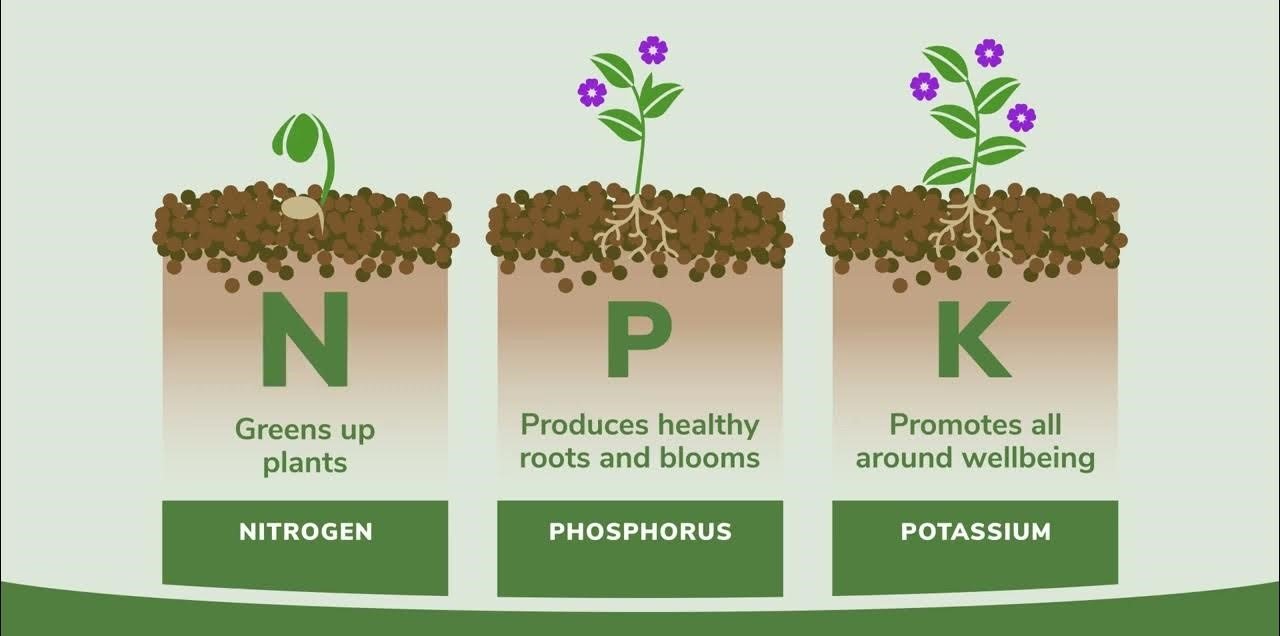The primary nutrients in fertilizers are Nitrogen (N), Phosphorus (P), and Potassium (K), commonly referred to as NPK. These macronutrients play critical roles in plant growth and development, supporting essential physiological processes.
1. Nitrogen (N)
- Role in Plant Growth:
- Promotes Leaf and Stem Growth: Nitrogen is a key component of chlorophyll, the molecule responsible for photosynthesis, which enables plants to convert sunlight into energy.
- Protein Synthesis: Essential for the production of amino acids, proteins, and enzymes that regulate plant metabolism.
- Cell Division and Growth: Vital for overall plant vigor and rapid development.
- Deficiency Symptoms:
- Yellowing of older leaves (chlorosis) due to insufficient chlorophyll.
- Stunted growth and poor foliage development.
- Overuse Effects:
- Excessive nitrogen can cause lush, green growth at the expense of fruit or flower production.
- Can lead to leaching, causing water pollution (e.g., nitrate contamination).
- Common Sources in Fertilizers:
- Ammonium nitrate, urea, ammonium sulfate.
2. Phosphorus (P)
- Role in Plant Growth:
- Energy Transfer: Phosphorus is a component of ATP (adenosine triphosphate), the molecule that stores and transfers energy in plants.
- Root Development: Promotes strong and extensive root systems, enhancing nutrient and water uptake.
- Flowering and Seed Production: Supports the development of flowers, fruits, and seeds, playing a critical role in reproductive growth.
- Photosynthesis and Metabolism: Contributes to the synthesis of nucleic acids and the structural integrity of cell membranes.
- Deficiency Symptoms:
- Purplish discoloration of leaves (due to accumulation of anthocyanins).
- Poor root growth and delayed maturity.
- Reduced flower, fruit, or seed development.
- Overuse Effects:
- Phosphorus buildup can reduce the availability of other nutrients (e.g., zinc, iron).
- Can lead to runoff into water bodies, causing eutrophication and algal blooms.
- Common Sources in Fertilizers:
- Superphosphate, monoammonium phosphate (MAP), diammonium phosphate (DAP).
3. Potassium (K)
- Role in Plant Growth:
- Regulates Water Balance: Potassium controls the opening and closing of stomata, regulating water loss through transpiration.
- Enzyme Activation: Activates numerous enzymes involved in photosynthesis, protein synthesis, and carbohydrate metabolism.
- Stress Tolerance: Enhances resistance to drought, disease, and extreme temperatures.
- Improves Quality: Promotes the production of high-quality fruits and grains by improving sugar, starch, and protein synthesis.
- Deficiency Symptoms:
- Browning or yellowing at leaf edges (scorch or burn).
- Weak stems, poor root systems, and reduced disease resistance.
- Low fruit or seed quality.
- Overuse Effects:
- Excess potassium can interfere with the uptake of other nutrients like calcium and magnesium.
- Common Sources in Fertilizers:
- Potassium chloride (muriate of potash), potassium sulfate.
How NPK Works Together
- Synergistic Effects:
- Nitrogen: Drives vegetative growth (leaves and stems).
- Phosphorus: Focuses on root development and reproductive growth (flowers, fruits, and seeds).
- Potassium: Enhances overall plant health, stress resistance, and quality.
- Balanced Application:
- The specific NPK ratio required depends on the crop type, soil conditions, and growth stage. For example:
- High-Nitrogen Fertilizer (e.g., 20-10-10): Suitable for leafy vegetables like lettuce and spinach.
- High-Phosphorus Fertilizer (e.g., 10-20-10): Ideal for root crops or flowering plants.
- High-Potassium Fertilizer (e.g., 10-10-20): Beneficial for fruiting crops like tomatoes and potatoes.
- The specific NPK ratio required depends on the crop type, soil conditions, and growth stage. For example:
Importance of NPK in Different Growth Stages
- Seedling Stage:
- Higher phosphorus supports root establishment.
- Vegetative Stage:
- Nitrogen promotes rapid leaf and stem growth.
- Flowering and Fruiting Stage:
- Potassium and phosphorus enhance flower and fruit development while nitrogen is reduced to prevent excessive foliage.
Conclusion
The balance of Nitrogen (N), Phosphorus (P), and Potassium (K) in fertilizers is critical for optimal plant growth and yield. Farmers and gardeners must choose the right NPK formulation based on crop type, soil analysis, and growth stage to ensure effective nutrient management while minimizing environmental impact.
Hashtags
#FertilizerBenefits #NutrientManagement #OrganicFertilizers #CropYield #FarmingTechnology #PlantHealth #EcoFriendlyFarming #NPKBalance #FertilizerApplication #SoilAmendments #PrecisionFarming #SustainableAgriculture #PlantNutrientUptake #FertilizerEfficiency #CropQuality #NPKRatio #FarmingSolutions #SoilTesting #FertilizerTypes #PlantGrowthPromoters









